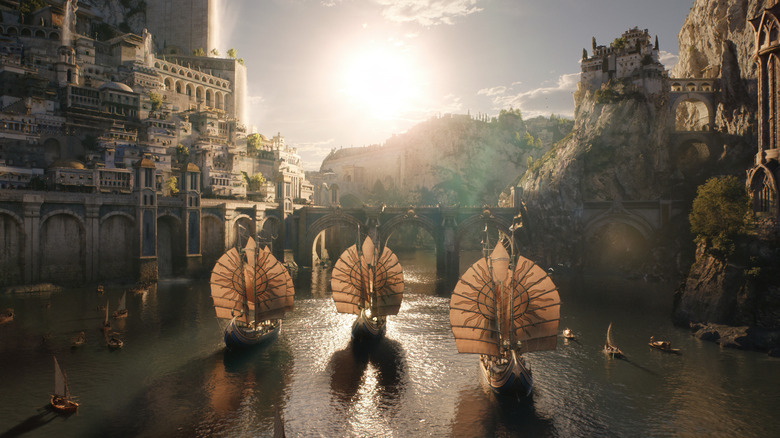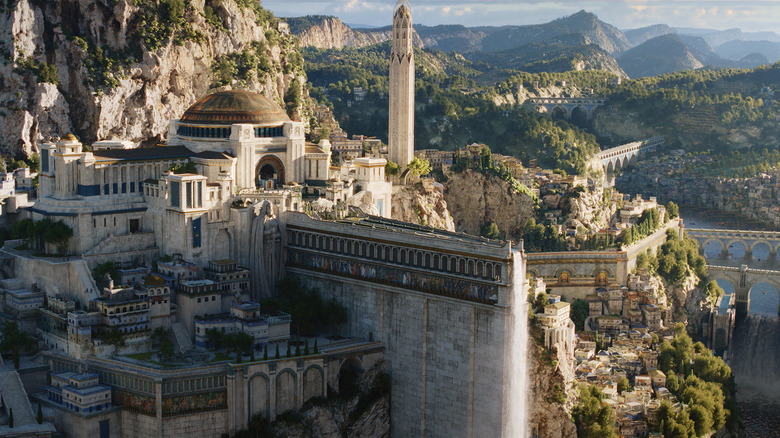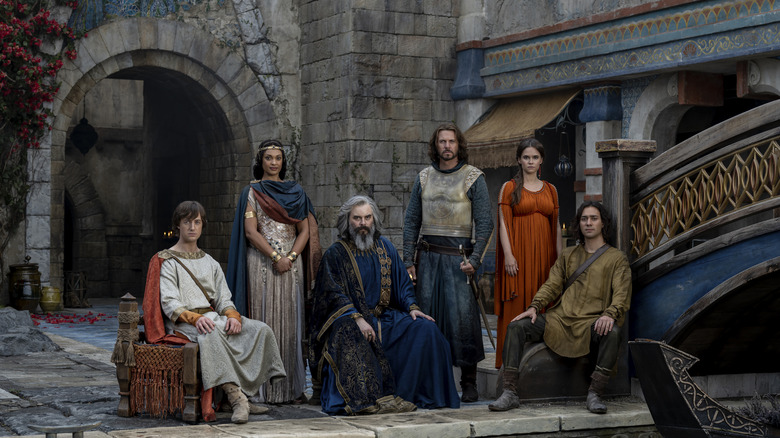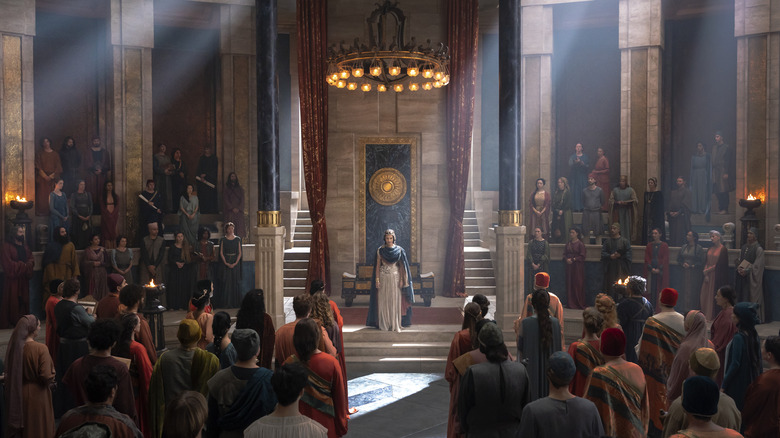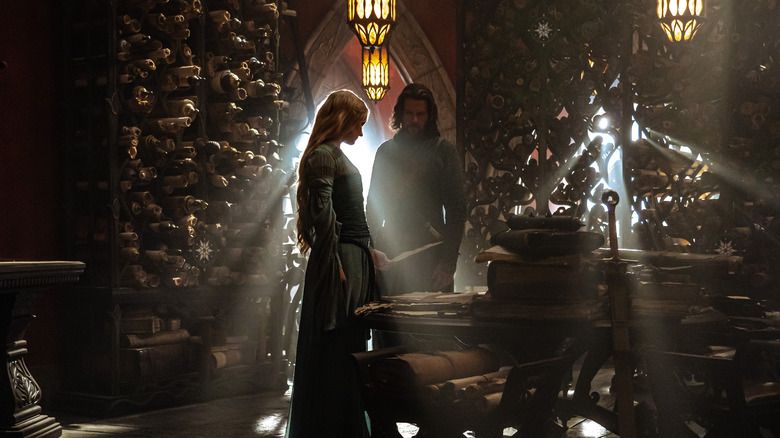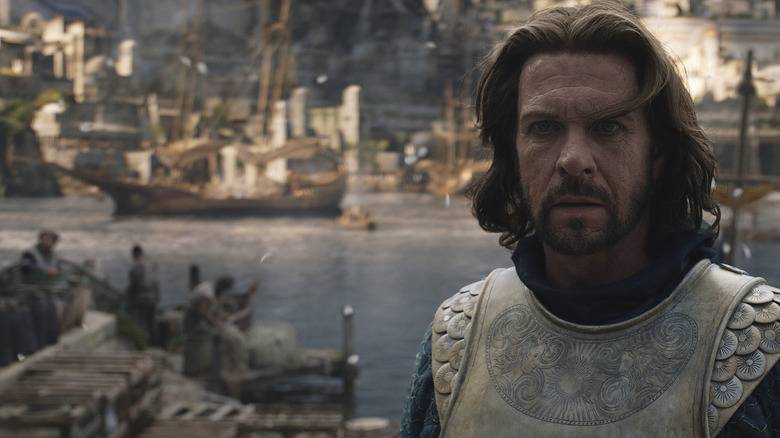The Rings Of Power Production Designer On Building Death Into The Walls Of Númenor [Exclusive Interview]
If there's one things that critics and viewers of "The Lord of the Rings: The Rings of Power" agree on, it's that the series' sets and visuals are simply stunning. I had the chance to talk with the show's production designer, Ramsey Avery, about all things Númenor, the human-populated island kingdom that we were introduced to in the latest episode.
Read on for that discussion, though be warned! We get into details of what we saw in episode 3 of the series. It also has spoilers for what ultimately happens to Númenor, something that won't be news to those familiar with Tolkien's work or those who have seen the Peter Jackson films.
This interview has been condensed and lightly edited for clarity.
'Gee, I just got back from Númenor. Oh, I mean Venice.'
Since episode 3 just dropped, I'd love to get to dig into Númenor specifically. I would love to hear how you approached creating this city — when you first sat down to bring this island city to life, what did you look toward for inspiration?
Well, I think there are two elements that actually set the signposts for Númenor. One was this letter that Tolkien wrote where he says, "Gee, I just got back from Númenor. Oh, I mean Venice." Venice evokes a certain sensibility in our heads, that there's a sense of wealth, a sense of beauty, a sense of lots of history, that it's been built up over time. Plus water, a lot of water.
The other element is this sense of it as the Atlantis of Middle-earth. In the third age of Middle-earth [the time period that ends with the events in "The Lord of the Rings" films], we see what leftover elements there are of Númenorian architecture and culture — we see Minas Tirith and Osgiliath — and we know that what those things look like.
In my head, the idea was that those are the ghosts of Númenor. That's what's left ... maybe a 1,000 people got rescued from a civilization of millions of people, so not every bit of technology, or culture, or knowledge, was able to be transferred from Númenor back to Middle-earth.
So, Minas Tirith looks like a part of Númenor, but it's not enough of it to actually represent the grandeur of the city. We looked at that Romanesque architecture we see in the movies, and we wanted to dial way up from that in terms of grandeur, beauty, and richness. That and this sense of Venice gave us a conceptual and an emotional standpoint for Númenor.
From there, I looked into what the cognates for that might be in our world. I wanted to get into the sense of history, so I looked back to very old bits of architecture and culture for us, like Babylonian architecture, and Sumerian architecture, and Minoan architecture, all of which are these big, blocky shapes.
What that sparked was the idea of differentiating between the cultures — elves, for example, have a definite look, that's very vertical and about nature; dwarfs have this thing where it's about the horizontal and the weight of the mountains, and the diagonals of the stone; and the humans in the Southland are all about this melting architecture, that's all soft and very earthen.
And so, for Númenor, the whole point is that it is this culture that is thriving. We turned toward shapes that have the strength and power — these squares, these domes, these arcs, all of which fit back to that Sumerian and Minoan architecture. And then layering on top of that those Romanesque forms that we see in the movies.
'We worked on creating 3,000 years of visual history'
The next thing that's super important is that Númenor was founded by humans who were being supported, trained, and taught by elves. All of that was very important at the beginning, so there should be a tremendous amount of Elven influence going in. Over time, however, they start to move away from that, and so we worked on creating 3,000 years of visual history in the city by the time we're getting to our story.
Because of this, Númenor has Elven architecture at its base, which is almost always at the lower levels of the city. And as you get up higher, it goes through these different levels of culture, where it's a little bit simpler. And then as we get a little higher up, it gets more decorative.
We actually did a whole document of how there were three major ages of Númenorian architecture so that we can define all of that. So, we have this visual storytelling that starts off Elven, becomes more human, then it becomes anti-Elven.
We put all of that into a pot basically, and then figured out what are the individual story beats that we needed to have. We literally started with the ship ride in, in terms of getting a feel for what this world would look like. We started with, what's the landscape? And then, how does the ship get into it? How does the city fit in that landscape? And then, what are the parts and the components of that? From that big view, we started to dial into individual set pieces.
It's interesting what you said about the three layers, because you can almost see in episode 3, in different spaces we see in Númenor that there's more influence of one versus the other. The Hall of Law, for example, seems more Elven than say the throne room.
For sure. The Hall of Law is definitely a much more ancient architecture so that's more specifically Elven. And the King's chambers are in the tower, and that would've been one of the first things the elves helped them build, so there's more Elven there. But by the time you get to the court, that's definitely anti-Elven. It goes against anything that could possibly be construed as Elven.
'The underlying idea of Númenor is that elves don't die, and humans do die'
Can you talk a little bit more about what you mean by anti-Elven, maybe using the throne room, as an example?
Elven is vertical and ethereal — there's this sense of always reaching for the stars. The underlying idea of Númenor is that elves don't die, and humans do die. And in the elves' sensibility and the gods' sensibility, they created humans to die for a reason. Everyone calls it a gift, and the idea behind that gift is that because humans have shorter lives, they're more active in that life and they're richer and stronger in a sense. To me, that meant that the architecture needed to be very potent. So the throne room, particularly that courtroom, needed to have this sense of strength, but also a sense of grandeur. There are the vertical lines in there, but it sits within this more massive space.
One of the other things that we wanted to do, specifically in the court, was to create the sense that we're always looking down the line — bad things are going to happen in this story, so how do you set that up? The Númenorians have no enemies — they control whatever they want to control so there's no reason for the king to be a dictator. So instead of having somebody high up on a throne, looking down on everybody, there's this circular space where everybody can join in the same space, and the throne is down on the same floor, more or less, as everybody else.
It was struck by all the tiling and bright colors in the alleyways. We also saw in the scene where there's a fight in a dark alleyway that the tiling is faded, showing that this is a sketchier part of town. How did you approach creating that tiling? And is there any specific little detail like that fading tile, that you really enjoyed bringing to the set?
One of the things that was fun was the idea that this is a maritime country. So, looking for any type of detailing that we could find that would suggest toward that sense of water. So, we've got wave patterns all over the place. We've also got fish, obviously. Everywhere you look, there's some version of fish. I love in the cantina, the columns actually have an octopus carved into the columns, holding up the column in there.
One of the things in that alleyway that I really like is we discovered that the Romans figured out how to make a type of concrete by using oyster shells. So, there's actually a section in that dark alley, which is that type of oyster shell concrete. So, you can see the oyster shells in it, which again is always about trying to bring the idea of the ocean into the architecture, everywhere we can.
We looked at a lot of Vienna secessionist styling for a lot of the detailing, and we also looked at a lot of Arabic styling, to try to introduce this idea of a Mediterranean culture.
'One of the decisions that I sold the showrunners on early is that elves didn't have bound books'
In the Hall of Law, I really like how the scrolls were stacked on top of each other. Can you talk a little bit about how you approached creating that room? And again, I noticed there seemed to be more Elven influence there than other places.
One of the decisions that I sold the showrunners on early is that elves didn't have bound books — they didn't invent book binding. We know that Elrond has books in the Third Age, but that doesn't mean that they had books in the Second Age. So, I wanted to tell the story that Númenorians invented book binding, and that this storage of older information, everything would have to be scrolls. I looked at a bunch of Tibetan storage, because of the scrolls, and I thought, "Wow, that's really cool because now we can have this whole space that's filled with scrolls."
Everybody talks about how much money we had, and we certainly had money, but we didn't have all the money in the world. And we also didn't have all the stage space in the world — we were still challenged to get things done with the amount of money we had. So this set actually is a repurposing of another set, and we needed some way to hide the walls of the other set. The scroll cabinets broke up the back walls and gave us a layer that hid the other set. Those walls actually get used as three different sets in the series.
Oh, interesting! Can you share the other sets?
Well, one of them I definitely can't share. The other one is, did we get to the dungeon yet?
I don't think we have.
I think that's episode 4.
'The city is built upon the dead of the Númenor, and you have that sense of death underwriting the whole culture'
Oh that's fun! I'll have to look extra close next episode. For my last question, I talked to the cast before the show premiered, and they had high praise for all the sets. I forget who told me this, but one of them mentioned how there was graffiti in Númenor where there's something written in Elvish, and it was overwritten in Númenorian, which I thought was just a fun little detail. Did you have any say in what that graffiti said?
It was something that we definitely went through the showrunners to do. We asked them what bits of storytelling do you want to tell here? And a lot of that is information about how the modern humans are going against the Elvish influence but there are the faithful that do want to maintain the Elvish influence. One thing I think is really worth noting is that what eventually brings the downfall of Númenor is that men don't want to die. And because of that, it was important to put death everywhere. We developed a couple of infinity symbols, and there's a broken infinity symbol. That gets repeated throughout the streets, and in the alleyways, there are these little columbaria, which are these little niches where the ashes of the dead are put, and there are little shrines to them. So literally, the city is built upon the dead of the Númenor, and you have that sense of death underwriting the whole culture. Some of the graffiti has to do with those types of storytelling as well.
New episodes of "The Lord of the Rings: The Rings of Power" drop on Fridays on Prime Video.
